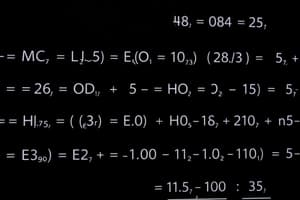Podcast
Questions and Answers
What does an empirical formula represent?
What does an empirical formula represent?
The simplest whole-number ratio of elements in a compound.
What is the difference between an empirical formula and a molecular formula?
What is the difference between an empirical formula and a molecular formula?
An empirical formula shows the simplest ratio, while a molecular formula shows the actual number of atoms.
Can different compounds have the same empirical formula?
Can different compounds have the same empirical formula?
Yes.
What is the empirical formula for both Benzene (C6H6) and Acetylene (C2H2)?
What is the empirical formula for both Benzene (C6H6) and Acetylene (C2H2)?
If a compound has a molecular formula of NH3 what is it's empirical formula?
If a compound has a molecular formula of NH3 what is it's empirical formula?
What information does percentage composition of a compound provide?
What information does percentage composition of a compound provide?
What information is needed to determine the empirical formula of a compound?
What information is needed to determine the empirical formula of a compound?
What are the two things the empirical formula represents in a compound?
What are the two things the empirical formula represents in a compound?
If a compound has a percent composition of 85.6% carbon and 14.4% hydrogen, what is the mass of carbon in a 100 g sample?
If a compound has a percent composition of 85.6% carbon and 14.4% hydrogen, what is the mass of carbon in a 100 g sample?
In the calculation of an empirical formula, after determining the number of moles of each element, what is the next step?
In the calculation of an empirical formula, after determining the number of moles of each element, what is the next step?
If the mole ratio of carbon to hydrogen in a compound is found to be 1:2.01, what is the approximate empirical formula?
If the mole ratio of carbon to hydrogen in a compound is found to be 1:2.01, what is the approximate empirical formula?
In calculating the mass percent of an element in a compound, what is the denominator in the calculation?
In calculating the mass percent of an element in a compound, what is the denominator in the calculation?
Why is it generally important to keep the maximum number of significant digits during empirical formula calculations?
Why is it generally important to keep the maximum number of significant digits during empirical formula calculations?
If an empirical formula calculation results in a ratio of $C_{1.5}H_3O_1$ , what is the next step to get whole-number subscripts?
If an empirical formula calculation results in a ratio of $C_{1.5}H_3O_1$ , what is the next step to get whole-number subscripts?
What is the empirical formula of a fuel that is 81.7% carbon and 18.3% hydrogen, after determining the mole ratio?
What is the empirical formula of a fuel that is 81.7% carbon and 18.3% hydrogen, after determining the mole ratio?
A compound contains 52.2% carbon, 6.15% hydrogen, and 41.7% oxygen. What is the empirical formula?
A compound contains 52.2% carbon, 6.15% hydrogen, and 41.7% oxygen. What is the empirical formula?
Flashcards
Empirical Formula
Empirical Formula
A formula that shows the simplest whole-number ratio of elements in a compound.
Molecular Formula
Molecular Formula
Shows the exact number of each type of atom in a molecular compound.
Empirical Formula vs. Molecular Formula
Empirical Formula vs. Molecular Formula
Different compounds can have the same empirical formula, but different molecular formulas.
Identical Empirical and Molecular Formulas
Identical Empirical and Molecular Formulas
Signup and view all the flashcards
Empirical Formula & Percentage Composition
Empirical Formula & Percentage Composition
Signup and view all the flashcards
Determining Empirical Formula from Percent Composition
Determining Empirical Formula from Percent Composition
Signup and view all the flashcards
Empirical Formula: Key Point
Empirical Formula: Key Point
Signup and view all the flashcards
Molecular Formula: Key Point
Molecular Formula: Key Point
Signup and view all the flashcards
Determining Empirical Formula
Determining Empirical Formula
Signup and view all the flashcards
Steps to Find Empirical Formula from Percent Composition
Steps to Find Empirical Formula from Percent Composition
Signup and view all the flashcards
Handling Decimals in Empirical Formula
Handling Decimals in Empirical Formula
Signup and view all the flashcards
Rounding Rules for Empirical Formula
Rounding Rules for Empirical Formula
Signup and view all the flashcards
Multiplying Subscripts for Whole Numbers
Multiplying Subscripts for Whole Numbers
Signup and view all the flashcards
Percent Composition
Percent Composition
Signup and view all the flashcards
Solving Empirical Formula Problems
Solving Empirical Formula Problems
Signup and view all the flashcards
Study Notes
Empirical Formula Basics
- An empirical formula represents the simplest whole-number ratio of atoms in a compound.
- It shows the elements present and their relative proportions, expressed as subscripts.
- It does not represent the actual number of atoms in a molecule, unlike a molecular formula.
Empirical vs. Molecular vs. Structural Formulas
- Empirical Formula: Shows the simplest whole-number ratio of elements.
- Molecular Formula: Shows the exact number and type of atoms in a molecule.
- Structural Formula: Represents the arrangement of atoms in a molecule.
Determining Empirical Formulas from Percentage Composition
- Assume a 100-gram sample if percentage composition is given.
- Convert the percentage of each element to grams.
- Calculate the number of moles of each element using its molar mass.
- Divide each element's mole value by the smallest mole value to obtain the smallest whole-number ratio.
- Round to the nearest whole number if necessary.
Determining Empirical Formulas from Mass
- Identify the elements present in the compound.
- Convert the mass of each element to moles using the element's molar mass.
- Divide each element's mole value by the smallest mole value to find the simplest whole-number ratio.
- Round to the nearest whole number to obtain the subscripts for the empirical formula.
Case of Decimals in Ratios
- If, during the process, a ratio contains a decimal part (e.g., 1.5), multiply all subscripts by the lowest common denominator (to maintain the correct ratio of atoms)
- Then, calculate the empirical formula
Examples
- Methane's empirical formula and molecular formula are both CH₄.
- Ethanoic acid's empirical formula is CH₂O while its molecular formula is C₂H₄O₂.
- Benzene and Acetylene have the same empirical formula (CH) but different molecular formulas.
Important Considerations
- Significant figures in calculations are crucial for accurate results.
- Rounding off intermediate values prematurely can lead to wrong results.
- Maintain accurate significant figures till the final answer.
Additional Notes
- Some compounds have identical empirical and molecular formulas (e.g., ammonia).
- The empirical formula provides essential information about the composition of a substance.
Studying That Suits You
Use AI to generate personalized quizzes and flashcards to suit your learning preferences.




